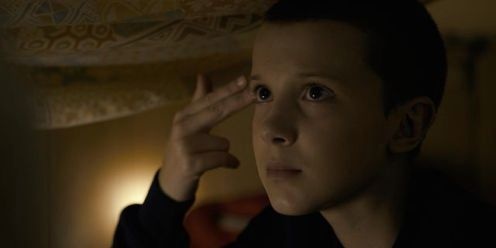
Here, in Chapter 2 of Stranger Things, the small-town setting is being utilized to great effect. We know what the reputations are for some of the adults, some of the teens and some of the younger kids. For a show (that seems to be, at least so far) about social norms and misfits and broken assumptions, it is certainly fitting that most of the characters seem to know (or think they know) everything about each other. Who has slept with whom. Which bikes and cars belong to whom. Which families are falling apart and why. Characters are being forced to question their more shallow notions of each other and their families, their kids, their parents, their siblings, their roles within the community. The balance of the community has been broken, and so, everyone feels the dizzying effects of that brokenness in their own unique ways. You can see the characters splitting into their respective age groups as a way of coping with the sudden lack of perspective and lack of trust in the presence of real danger.
Compared to many similar thrillers and horror shows (in movies and TV and genre fiction), this show leaves more room for the differing perspectives of different age groups. Impending adolescence is as big a theme as impending adulthood. And the adults are finding the ground opening up underneath them, mostly in the form of external threats. The potential audience of this TV series is much broader than many of the films that this show is referencing. We don’t get a primarily childlike perspective, as we do in films like E.T., Goonies, or The Explorers, and this isn’t just a show for a merely teenage crowd either (Ferris Bueller, Edward Scissorhands and the films of the late John Hughes come to mind). So far, the adults are still the least sympathetic group in this community of characters, although the show doesn’t seem to be dismissing their shallow pragmatism outright. They are mostly still just reacting, and are only beginning to probe the “bad luck” of the seemingly disparate events that are playing out in the small town. But I’m hopeful. There are still 6 episodes left in which to explore various responses to their overturned internal and external worlds.
At the end of this second chapter, another character vanishes, apparently at the hands of the unknown evil entity. In an attempt to make sense of what is happening, I find myself searching for connections between these two disappearances. Perhaps the evil presence is targeting those who are the most vulnerable in the community? Is it choosing a representative from every age group for some reason? Much the same way, the youngest and oldest groups of characters are beginning to question the possible connections between different unusual events. And all three age groups represented in this story are being forced into making tough decisions.
The adults are looking to reconcile the disappearance of the young boy, Will, with the death of the cook at the diner (in the process, they mistakenly conclude that Will and “11,” the mysterious child who showed up at the diner, must be the same person). Will’s mother must make a clear choice at the end of this episode: (should I stay, or should I go now? Get it?) To find her son, she must turn and face a great horror: which is an act of turning around and walking back into her own house. To help her son, or to understand what has happened to him, she must stay home. She must turn and face the most familiar spaces in her life, as if for the first time. Are the adults going to be able to reckon with the monsters that threaten their children? Are they in denial? Have they ever truly faced the real monsters in their own lives or are they only now beginning to?
The youngest children wrestle with difficult choices too: do they keep searching for Will? Do they turn in the mysterious girl they have discovered? By the end of this second chapter, it has become clear that, in order to find Will, they must try to hide the girl and discover more about her at the same time. (Puberty is approaching – get it?) In their relative innocence, perhaps they are better positioned to recognize what the hell is going on even if they are not able to interpret what the hell it all means. Their pieces of the puzzle do not help them to define the edges of the picture frame, but they hold the starker pieces: the pieces that contain the eyes, the fangs, the claws…
And then there are the teenagers, who (most of them, anyway) seem the most scattered, barely acknowledging the disappearance of the young boy in the community. They are mostly unfocused, as if they are separating the puzzle pieces into various colors. They lose sight of the things that they say are important to them. Do they choose to restrain their passions? Do they indulge their own curiosities? Are they in the most danger if they are not able to follow the natural progression toward their own burgeoning sexuality?
I think we’re getting somewhere. I believe I started out expecting too much of this entertaining show. I probably still am. But I am looking forward to the next chapter, and waiting a little bit between episodes has been rewarding, in a number of ways. Perhaps for one of the upcoming chapters, I’ll try waiting a whole week before moving on to the next one. You know, kind of like how you had to wait for broadcast TV back in the 1980s.



